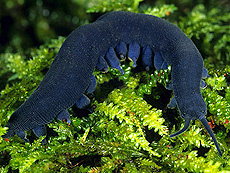Indigo velvet worm facts for kids
Quick facts for kids Peripatoides indigo |
|
|---|---|
 |
|
| Female P. indigo | |
| Conservation status | |
| Scientific classification | |
| Kingdom: | |
| Phylum: | |
| Family: |
Peripatopsidae
|
| Genus: |
Peripatoides
|
| Species: |
P. indigo
|
| Binomial name | |
| Peripatoides indigo Ruhberg, 1985
|
|
The Peripatoides indigo is a special type of velvet worm. These amazing creatures are part of a group called Onychophora. In the Māori language, velvet worms are known as ngaokeoke. This name comes from the Māori word 'ngaoki', which means 'to crawl'.
Contents
What Does the Blue Velvet Worm Look Like?
The Peripatoides indigo can grow up to 9 centimeters (about 3.5 inches) long. It has a beautiful deep blue or purple color. This is why it's often called the "blue velvet worm." Its skin looks velvety because it has many tiny bumps called papillae. These bumps also have fine bristles, which are like tiny hairs.
At the front of its body, the P. indigo has two long antennae. It also has small mouth parts called oral papillae. These parts are very important for hunting. They can shoot out a sticky, paralyzing slime! This slime helps the worm catch its prey.
The P. indigo has 16 pairs of short legs. Each leg has a hook-shaped claw at the end. These worms have a unique body structure. They have a hydrostatic skeleton, which means their body is filled with fluid and muscles, like an earthworm. But they also have a chitinous exoskeleton, which is a tough outer shell like insects have.
Because of its exoskeleton, the P. indigo needs to shed its skin as it grows. This process is called moulting or ecdysis. It happens every few weeks. The worm's many legs work together to help it move. It can travel about 200 millimeters (about 8 inches) in a minute. This is quite slow compared to other animals.
Velvet worms have simple eyes. These eyes mainly help them tell if it's light or dark. This is important because they come out at night. Coming out at night helps them avoid drying out. The P. indigo breathes through small holes on its sides called spiracles. Unlike many animals, these spiracles are always open. This means the worm can easily lose water from its body. To stay safe and moist, the P. indigo needs to live in damp, humid places.
Where Does the Blue Velvet Worm Live?
The Peripatoides indigo has been found in the Nelson area of the South Island, New Zealand. Velvet worms usually live in forests. However, this species has also been seen in city parks, scrub areas, and even gardens.
Their favorite places to live are under rocks, inside rotting logs, and in leaf litter. These spots are perfect because they are damp and humid. This helps the P. indigo stay moist and not dry out. As mentioned before, these worms are nocturnal, meaning they are active at night. This also helps them avoid losing too much water when the sun is out.
The P. indigo is a predator. This means it hunts and eats other small creatures. Its diet includes beetle larvae, spiders, isopods (like pill bugs), and other insects found in leaf litter. They also eat soil to get nutrients. After moulting, they even eat their own shed skin! This helps them get back any lost nutrients.
When hunting, these animals shoot a glue-like slime from their mouth parts. This slime makes their prey unable to move. Once the prey is stuck, the P. indigo gets close. It then injects special digestive saliva into the prey. This saliva turns the prey's insides into liquid, which the worm then sucks up. New Zealand velvet worms can shoot this slime several centimeters away. They also use it to defend themselves if they feel threatened.
Scientists are not sure what animals might eat the P. indigo. It's possible that introduced animals like birds or rats could be predators. However, there are no recorded observations of this happening.
Reproduction and Life Cycle
The Peripatoides indigo, like other Peripatoides species, is ovoviviparous. This means the mother keeps the eggs inside her body until they hatch. Then, she gives birth to live young.
The P. indigo is thought to live for up to five years. Female worms can have 10 to 20 babies each year. When they mate, the male places a packet of sperm, called a spermatophore, onto the female's body. The female then absorbs this sperm. It travels to her eggs or is stored until it's needed. The eggs hatch inside her, and she gives birth to tiny versions of the adult worm.
Scientists haven't seen parents caring for their young after they are born. In fact, sometimes the mother might even eat her own young.
Protecting the Blue Velvet Worm
The Peripatoides indigo has a special conservation status in New Zealand. It is classified as "At Risk, Naturally Uncommon." This means it's not found in many places and could be in danger. It is also listed as Vulnerable on the IUCN Red List. The IUCN Red List is a global list that tracks the conservation status of species.
The main threat to this species is habitat destruction. This includes clearing forests, removing logs and rocks where they live, and other events like fires. Sometimes, too many worms might be collected by people, especially adult females. Other threats include being eaten by introduced animals, such as birds and rats. Protecting their damp, humid homes is very important for the survival of the Peripatoides indigo.


